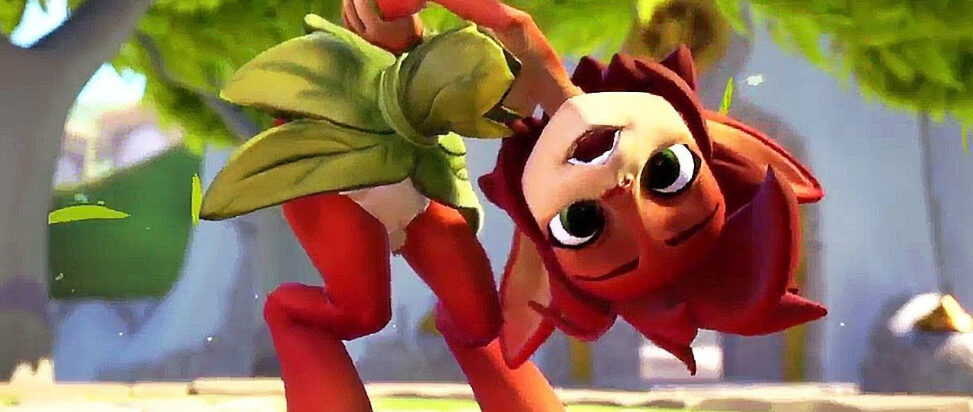
Elora the Faun from Spyro 2: Ripto’s Rage

This column is a reprint from Unwinnable Monthly #163. If you like what you see, grab the magazine for less than ten dollars, or subscribe and get all future magazines for half price.
———
Fictional companions and goth concerns.
———
“I’m a faun, you dork!”
This is how Elora the Faun meets Spyro the Dragon in Spyro 2: Ripto’s Rage. Our hero, Spyro, has gotten sucked through a portal to the kingdom of Avalar, where he meets Elora – a humanoid brunette with goat legs. Spyro’s introductory question: “What are you, some kind of goat?” Not great, Spyro.
As Unwinnable’s Myths and Legends issue approached, I happened to be playing the Spyro Reignited Trilogy and once again thinking about Elora, who fascinated me as a folklore-obsessed youth. I was always looking for historical magic in contemporary media as a kid. I still am, and now I get to write about it.
The word “faun” derives from Faunus, an ancient Roman deity of fields and forests. Faunus later became equated with the Greek god Pan – a satyr – but to the ancients, they were separate entities. Like Pan and Faunus, satyrs and fauns are often conflated now, but in old school depictions, satyrs looked more like hairy woodwoses (wild men), sometimes with horse-like rather than goat-like attributes. Satyrs were also often depicted with permanent erections which, uhhh, fortunately did not apply to the kindly faun Mr. Tumnus in The Lion the Witch and the Wardrobe.

In Virgil’s Aeniad, we learn about the oracle of Faunus – a sacred woodland grove where the voice of the gods, and of Faunus himself, might be heard. In A.S. Kline’s translation, Virgil tells us that the “people of Italy, and all the Oenotrian lands, sought answers / to their doubts, from that place: when the priest brought / offerings there, and, found sleep, in the silent night, lying / on spread fleeces of sacrificed sheep, he saw there many ghosts / flitting in marvellous forms, and heard various voices, had speech / with the gods.” King Latinus, Faunus’ son, sought answers there from “his far-speaking father” where he “breathed a deadly vapour from the dark.” Goth. At the oracle, Faunus specifically told Latinus to marry his daughter off to a foreigner – a little presumptuous, but if there’s one thing I know about classical kings and gods, it’s that they love marrying off their daughters.
So, what does any of this have to do with Elora?
Fauns went through a lot of artistic incarnations between the Aeniad and Spyro 2, like the pastel-furred little boy fauns in Disney’s Fantasia (1940) or the aforementioned Mr. Tumnus from C.S. Lewis’ Narnia series (1950). Some significant fauns came after Elora as well, my favorite being the deeply spooky faun who guides a little girl to the underworld in Pan’s Labyrinth (2006).
Unlike the above masculine figures, Elora is a femme with no known daughters to marry off or proclivities toward luring little girls anywhere. But aspects of her character still harken back to the fauns of mythology.
Elora is not specifically oracular, but she boasts a lot of knowledge. She’s responsible for giving Spyro a magic guide to Avalar (the in-game guidebook), and for imparting general information about the world.
While fauns represent a lot of things – revelry (like satyrs), fruitful fields, herding, rewilding (as it were) – they are ultimately creatures of the forest, and this also brings us back to Elora. Per Britannica: Faunus “eventually became primarily a woodland deity, the sounds of the forest being regarded as his voice.”
In the original Spyro trilogy, we see Elora wearing a series of green triangles as her top. In the remaster, said green triangles have morphed into a lovely leaf dress with matching bracelets. That’s forestcore fashion at its finest.
Prior to Spyro’s rude question about her goat legs, Elora asked him to meet her in Summer Forest, where a villain has overtaken the Summer Forest castle. It’s Spyro’s job to collect talismans from various interconnected worlds to restore the land while Elora instructs him and cheers him on. Spyro is trying to finish the job so he can go on vacation; Elora is the one who cares about restoring her home world.
Maybe, even in the parallel universe of Avalar, Elora hears the voice of her progenitor, Faunus. If she ever opens a portal to this dimension, maybe she’ll seek out the Oenotrian lands and find the oracle of her divine ancestor. Bring an offering, Elora, and breathe those deadly vapors from the dark. You’re a faun; you’ll be fine.
———
Deirdre Coyle is a goth living in the woods. Find her at deirdrecoyle.com or on Twitter @deirdrekoala.




